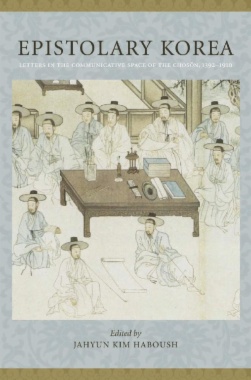By expanding the definition of "epistle" to include any writing that addresses the intended receiver directly, JaHyun Kim Haboush introduces readers to the rich epistolary practice of Chos?n Korea. The Chos?n dynasty (1392-1910) produced an abundance of epistles, writings that mirror the genres of neighboring countries (especially China) while retaining their own specific historical trajectory. Written in both literary Chinese and vernacular Korean, the writings collected here range from royal public edicts to private letters, a fascinating array that blurs the line between classical and everyday language and the divisions between men and women. Haboush's selections also recast the relationship between epistolography and the concept of public and private space.
Haboush groups her epistles according to where they were written and read: public letters, letters to colleagues and friends, social letters, and family letters. Then she arranges them according to occasion: letters on leaving home, deathbed letters, letters of fiction, and letters to the dead. She examines the mechanics of epistles, their communicative space, and their cultural and political meaning. With its wholly unique collection of materials, Epistolary Korea produces more than a vivid chronicle of pre- and early modern Korean life. It breaks new ground in establishing the terms of a distinct, non-European form of epistolography.
- Contents
- Acknowledgments
- Explanatory Note
- Introduction: The Epistolary Genre and the Scriptural Economy of the Chosŏn
- I. Public Letters
- 1. Royal Edicts: Constructing an Ethnopolitical Community
- 2. Female Rulers: Queen Dowagers’ Edicts and Letters
- 3. Memorials to the Throne
- 4. Joint Memorials: Scholars’ Channel of Communication to the Throne
- 5. Individual Petitions: Petitions by Women in the Chosŏn
- 6. Petitions by a Collective Body: A Petition by the Residents of the Chip’yŏng District
- 7. Letters of Appeal
- 8. Circular Letters in Chosŏn Society: Writing to Publicize Opinions
- 9. Open Letters: Patriotic Exhortations from the Imjin War
- 10. Manifestos During the Hong Kyo�ngnae Rebellion of 1812
- 11. Chŏn Pongjun’s 1894 Tonghak Declaration
- 12. Letters to the Editor: Women, Newspapers, and the Public Sphere in Turn-of-the-Century Korea
- II. Letters to Colleagues and Friends
- 13. Correspondence Between Scholars: Political Letters
- 14. Scholarly Letters
- 15. Friendship Between Men
- 16. Friendship Between Women: One Man’s Consorts
- 17. Friendship with Foreigners
- III. Social Letters
- 18. Letters of Greeting
- 19. Letters on Everyday Life
- 20. Male Concubinage: Notes on Late Chosŏn Homosexuality by an American Naval Attaché
- IV. Family Letters
- 21. Letters Between Spouses
- 22. Personal Royal Letters: Correspondence Between Monarchs and Their Children
- 23. The Sunch’o�n Kims: Vignettes of Family Life Through Letters
- 24. Fathers’ Letters Concerning Their Children’s Education
- 25. Mothers’ Letters of Instruction to Their Children
- 26. Yi Ponghwan’s Letters to His Mother During His Trip to Japan
- 27. Daughters’ Letters to Members of Their Natal Families
- V. Letters Written Away from Home
- 28. Letters Written in Korean by Exiles
- 29. A Letter Written in Literary Chinese by Chŏng Yagyong While in Exile
- 30. Letters by Prisoners of the Imjin War
- 31. Letters Sent Home by Royal Hostages
- VI. Deathbed Letters
- 32. A Letter Written Before Execution: A Condemned Man’s Last Thoughts to His Children
- 33. Letters of the Catholic Martyrs
- 34. Madam Yi’s Farewell Letter to Her Son
- 35. Daughters’ Letters of Farewell to Their Fathers
- VII. Letters to the Dead
- 36. A Wife’s Letter to Her Deceased Husband
- 37. Kwŏn Sangil’s Farewell to His Deceased Wife
- 38. Letters to Deceased Children
- VIII. Fictional Letters
- 39. Love Letters in The Tale of Unyŏng
- Bibliography
- Index

